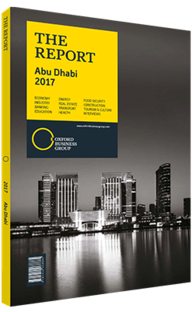Abu Dhabi bond issuance helps fund large-scale projects
The more than 60% fall in the price of crude oil from its mid-2014 high has had a considerable effect on the way hydrocarbons-producing economies such as Abu Dhabi meet their fiscal commitments. The sizeable pools of wealth at the government’s disposal mean that it is not necessary for it to go to the debt market to meet these obligations (see Economy chapter). Nevertheless, bond issuances provide an attractive solution to the fiscal challenge in that they allow Abu Dhabi to maintain its spending programmes without drawing down its foreign reserves or liquidating its many international investments.
Sovereign Bond Sale
With these considerations in mind, in 2016 Abu Dhabi staged its first sovereign bond sale for seven years, with the emirate’s Department of Finance raising $5bn through a pair of $2.5bn tranches: a five-year yielding 2.125% and a 10-year instrument yielding 3.125%.
The sale was significantly larger than the $1.5bn offering of 2009 which preceded it, and was made viable by the emirate’s strong credit ratings, with rating agencies Standard & Poor’s and Fitch both granting the emirate an “AA” rating for its long-term debt, placing it firmly in the “high grade” investment category. The renewed debt issuance activity at the emirate level has also revived interest in the prospect of federal sovereign offerings.
An absence of a national law to govern sovereign issuances by the UAE has hitherto precluded any federal-level bond sales, although the issue has been on the agenda for some time.
In 2016 the federal cabinet edged closer to establishing a suitable framework for such activity, with reports in the international press suggesting that a draft law would be in place by the fourth quarter which would allow the federal government to issue bonds up to a set percentage of GDP.
Reaching a final agreement on debt ceilings and debt servicing has proved challenging in the past, and appeared to be the principal cause of the draft law’s delay in 2016. However, the prospect of a new federal debt law and the subsequent attainment of a federal credit rating for the UAE remains a real one in 2017, and one which will significantly alter the manner in which the nation utilises the debt capital markets to fund its national development.
Looking ahead, the future trajectory of oil prices is expected to encourage yet more sovereign issuance in the region. At the close of 2016 ratings agency Fitch predicted that, “Given the shift in oil prices and our expectation that they will only recover to around $65 a barrel in the long term, we believe sovereign issuance from GCC members will become a more regular feature of these markets.”
Corporate Interest
The prospect of a longer-term rise in sovereign issuance holds positive implications for the corporate bond arena, as the yields established on various iterations of state debt create a useful pricing benchmark by which other debt instruments in the same market can be priced.
Traditionally, the robust liquidity and strong lending appetite of regional banks have constrained the growth of corporate issuance in the region, as larger commercial enterprises have found it easy to secure cheap bank credit to finance their expansion.
This extends to the numerous entities which the government maintains an interest in. In the second quarter of 2016 the local press reported that a number of government related entities were exploring finance options from international lenders as a response to the new oil price scenario.
However, corporates are likely to begin to look carefully at the debt market as their borrowing costs increase due to shrinking bank deposits and climbing interest rates. How the borrowing from banks versus bond-issuance ratio is altered over the coming year will therefore be one of the more interesting capital market issues of 2017 and in subsequent years.
You have reached the limit of premium articles you can view for free.
Choose from the options below to purchase print or digital editions of our Reports. You can also purchase a website subscription giving you unlimited access to all of our Reports online for 12 months.
If you have already purchased this Report or have a website subscription, please login to continue.

